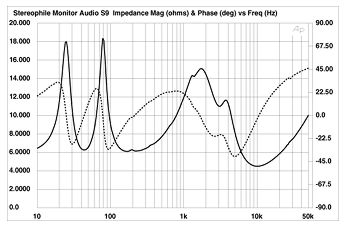| Columns Retired Columns & Blogs |
Monitor Audio Silver 9i loudspeaker Measurements
Sidebar 4: Measurements
The slim Monitor Audio Silver 9i tower was 5.5dB more sensitive than my reference Rogers LS3/5A, at 88dB(B)/2.83V/m—below specification but still higher than average—while its plot of impedance magnitude and electrical phase angle against frequency (fig.1) revealed it to be a pretty easy load for the partnering amplifier to drive. It drops below 6 ohms only in the high treble, where there is rarely any high-level energy. Although the phase angle is quite heavily capacitive in part of the mid-treble region, the magnitude is generally above 6 ohms, mitigating the effect of this angle. The port tuning, as indicated by the "saddle" between the two bass peaks in the magnitude curve, lies at 42Hz, the lowest note of the four-string bass guitar or double bass.

Fig.1 Monitor Audio Silver 9i, electrical impedance (solid) and phase (dashed). (2 ohms/vertical div.)
Some resonance-induced wrinkles can be seen in this graph, particularly at 200Hz. However, examining the cabinet's vibrational behavior with a plastic-tape accelerometer indicated one major mode, at 350Hz; this could be detected on all surfaces (fig.2). There is a very slight wrinkle at this frequency in the impedance traces, but nothing mechanical to explain the lower-frequency phenomenon.

Fig.2 Monitor Audio Silver 9i, cumulative spectral-decay plot calculated from the output of an accelerometer fastened to the cabinet top. (MLS driving voltage to speaker, 7.55V; measurement bandwidth, 2kHz.)
However, when we look at the individual responses of the port, lower woofer, and upper woofer/tweeter (fig.3), a big peak at 200Hz can be seen in the port's output. The fact that the port faces away from the listener probably explains why El Bee was not bothered by any lower-midrange coloration. The port output is the bandpass curve centered on the 25-80Hz region, though the woofers do not feature the usual single minimum-motion point.

Fig.3 Monitor Audio Silver 9i, acoustic crossover on tweeter axis at 50", corrected for microphone response, with the nearfield woofer and port responses plotted below 300Hz and 1kHz, respectively.
Both woofers have a resonance peak in the mid-treble, the lower woofer's very slightly higher in frequency, while the tweeter has a very high double peak just below 30kHz. The lower woofer can be seen in fig.3 to roll off slowly compared to the upper, whose response gently rises through the midrange. When the two outputs are summed, the increasing contribution from the lower woofer with decreasing frequency will flatten the overall midrange response (fig.4). Even so, the curve has a slight emphasis in the 1-3kHz region, which will, as El Bee noted, make the speaker's balance sound a bit forward. This will be slightly exacerbated by the peak just below 5kHz and the tweeter's rising trend between 5 and 10kHz. You can see that the port resonance at 200Hz gives rise to a notch in the summed woofer outputs at the same frequency, while the port output is shelved down. As Lonnie noted, this speaker should be used quite close to the wall behind it to bring its midbass into better balance with the higher-frequency output. With the Monitors well out in the room, the balance will be a bit lightweight, though very detailed.

Fig.4 Monitor Audio Silver 9i, anechoic response on-axis at 50", averaged across 30 degrees horizontal window and corrected for microphone response, with the complex sum of the nearfield woofer and port responses plotted below 300Hz.
- Log in or register to post comments




































